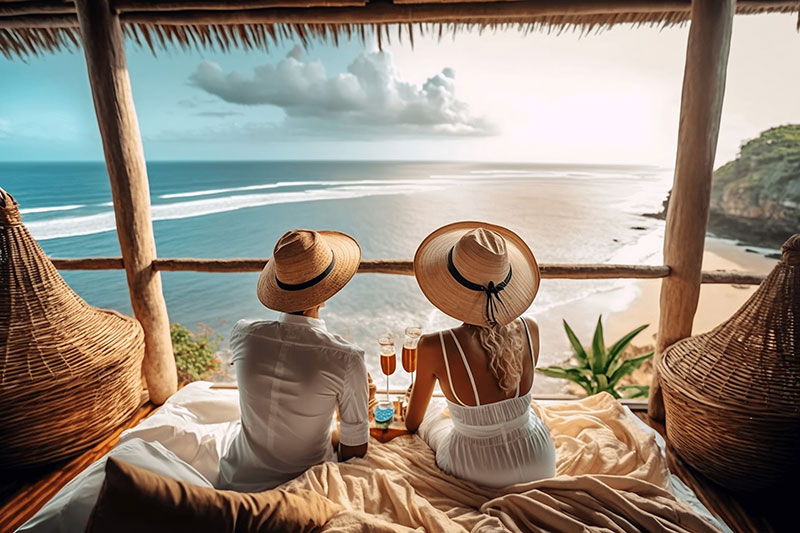Study shows human presence in venue photos can turn off viewers

Social media marketers routinely share photos of people vacationing in exotic locales or attending events at exclusive venues, but new research from a professor at Tulane University’s A. B. Freeman School of Business suggests that those photos of prior customers may actually be driving new consumers away.
In a forthcoming paper in the Journal of Consumer Research, Assistant Professor of Marketing Zoe Lu and co-authors Suyeon Jung and Joann Peck find that the presence of another human in photos of “experience venues” — venues that host experiences relevant to the photo viewer’s self-identity — can lower the viewer’s liking and preference for the venue in the photo.

“When it’s an experience closely tied to self-identity, like vacations or weddings, people want to feel personal ownership,” explains Lu. “The presence of another human in the photo is enough to make the photo viewer feel that the venue or destination is ‘theirs,’ not ‘mine,’ so they tend to view the venue less favorably.”
For the study, Lu and her co-authors analyzed a set of field data comprising more than 14,000 Instagram travel photos from a top influencer and conducted a series of experiments that asked viewers to choose between venues with or without another person in the photo. Across a diverse range of experience venues — including travel destinations, wedding venues, hiking trails, performance centers and restaurants — the authors consistently found that the presence of prior consumers in the photo lowered viewers’ liking and preference for the destination or venue pictured.
The study is the first to investigate the impact of human presence in shared photos through the lens of psychological ownership and the identity-signaling function of ownership. Consumers often construct and communicate identity through ownership, and photos of a person at an identity-relevant experience — such as a wedding, vacation or special dinner — represent a kind of virtual ownership of that venue. When consumers see other people in photos of an identity-relevant experience, they tend to attribute ownership of the venue to others and consequently view the venue less positively.
The effect is moderated by the relevance of the experience to the viewer’s identity as well as the distinctiveness of the person in the photo. If the experience in the photo is not relevant to the viewer’s identity — such as a wedding planner choosing a venue for a client as opposed to a couple picking the venue for their own wedding — the presence of prior consumers in the photo doesn’t affect the viewer’s liking of the venue. Likewise, if the person in the photo has a distinct identity that doesn’t pose a threat to the photo viewer’s self-identity — such as an employee of the venue or the venue's owner — the person’s presence in the photo does not lower the viewer’s preference for the venue.
Lu says the study’s findings offer a number of practical insights for marketing professionals.
- Advertisers should be cautious about using photos of prior customers in photos promoting identity-relevant experiences as those photos can lower consumers’ likelihood of choosing the venue in the photos.
- If marketers want to include people in photos promoting an experience venue, they should feature people who don’t compete with the viewer for the same identity, such as employees or the owner of the venue.
- If venues encourages consumers to share their personal photos online, they should discourage them from posting selfies or photos with other customers present.
While photos with people can often feel more engaging or authentic, Lu says her study shows they can sometimes undermine marketing goals. Carefully considering the consumer experience being featured and the role of the people pictured can help venues optimize their visual content marketing.
“It Looks Like ‘Theirs’: When and Why Human Presence in the Photo Lowers Viewers’ Liking and Preference for an Experience Venue,” co-authored by Lu, Suyeon Jung and Joann Peck, is forthcoming in the Journal of Consumer Research.
Interested in advancing your education and/or career? Learn more about Freeman’s wide range of graduate and undergraduate programs. Find the right program for you.
Recommended Reading
- Energy students attend Gulf Coast Energy Forum
- Daniel Mochon: Navigating the Noise
- Matthew Higgins: The Strategy of Innovation
- Pierre Conner: The Future of Energy Is Now
- What Can You Do With a Business Analytics Degree?
- Ukrainian scholar to discuss economic impacts of war
- Join the Freeman School for Homecoming 2012
- Burkenroad Symposium tackles ethics of social media
Other Related Articles
- New study shows how personal profiles transform social media customer service
- Research Notes: Shuhua Sun
- Newsweek: The Real Cost of Layoffs Isn’t In the Financials
- Research Notes: Yang Pan
- CNN: Stocks rise ahead of tech earnings as Nvidia hits $5 trillion valuation
- Forbes: Your Pitch Deck Doesn’t Close the Deal - Your Power in the Room Does
- Research Notes: Alissa Bilfield
- Quartz: Companies that replace workers with AI ‘risk mediocrity,’ expert warns
